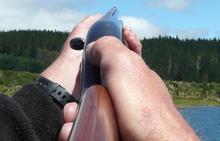Lead shot for waterfowl hunting has been phased out.
Hunters are required to use non-toxic shot when hunting waterfowl within 200 metres of water.
2021 saw a complete ban on the use of lead shot for all but 410 gauge, and that exemption ended at the end of the 2023 game bird hunting season.
This ban will be strictly enforced on public, private, DOC and Fish & Game land for all hunters you must use non-toxic shot, nothing else.
The phase-out of lead shot follows research that shows that waterfowl get poisoned when they pick up fired lead shot and eat it as a grit substitute to help them digest their food. New Zealand research showed the problem was the same here as in overseas countries.
Non-toxic shot does not contain lead and the most commonly available type uses steel pellets. Steel shot is already widely used in New Zealand.
Check out some frequently asked questions about Non-Toxic shot here.
Read more about lead poisoning in game birds here
Why ban lead shot?
Lead shot has been banned or restricted in many parts of the world for many years because it's been shown to poison ducks that accidentally eat it as grit.
Studies showed that New Zealand was no different to other countries that had already switched to non-toxic shot.
The Government made the decision to go non-toxic and requested Fish & Game to implement a staged and progressive introduction of non-toxic shot provisions several years ago.
Who's affected?
- ALL waterfowl hunters including private landowners hunting on their own property
- ALL waterfowl hunters hunting or killing waterfowl within 200m of water
- ALL hunters of waterfowl (swans, ducks and pukeko)
Who's exempt?
- ALL hunters of upland game (all quail and pheasants) are exempted. That's because research has shown these birds are not affected because the shot "in the uplands" is so widely dispersed
- All hunters who pass the "200m rule test" (see below)
200-metre rule test
- If you're hunting waterfowl (swans, ducks and pukeko), MORE THAN 200 metres from a water body, which is taken as any stream, river, lake or tidal area, "more than 3m wide," you can continue to use lead shot, if you wish. Lead shot that falls on land away from water is not a significant risk to waterfowl
- If you are within 200m of a waterway, over 3 metres in width, and while upland game bird hunting with lead and encounter a duck, then either don't shoot at it with lead or cover your risk by using only non-toxic shot
- If you are hunting BOTH upland AND waterfowl within 200m of a waterway, more than 3m in width, then you must use ONLY non-toxic shot
- If you are hunting waterfowl within 200m of a waterway, more than 3 metres wide and you are in possession of BOTH lead and non-toxic ammunition you will be prosecuted. If your intention was to hunt upland game later with lead shot or to hunt waterfowl with lead later beyond the 200m rule, you need to be completely unambiguous about this. For instance, by keeping the lead ammunition back in the vehicle when you are hunting waterfowl within the 200m zone
- If you hunt in a tidal area, then the 200m rule applies from the Mean High Water Mark. So you may be 500 metres away from the water's edge at low tide, but this is not a defence. Similarly, if you're hunting next to floodwaters it is the edge of the floodwater at that time that you measure the 200m from.
Why is it so complicated?
The 200m rule may sound like an odd exemption, but it does allow, for instance, hunting waterfowl over paddocks with lead. The Government originally proposed that ALL lead shot be banned for all activities, including ALL upland game bird hunting, ALL clay target shooting and ALL farm pest control. Fish & Game was successful in having this extreme requirement softened.
The 200m rule recognises that lead is not a problem away from waterways.
While the 200m rule could be criticised, no one has yet thought up a better rule to fit the circumstances. The concessions have been hard fought for to allow for paddock shooting of ducks and parries especially, please respect them.
For more information, please read our Toxic Shot Regulations FAQ.
Max. Shot Sizes & Non-Toxic Energy Equivalents
Read this extensive article by John Dyer, Senior Wildlife Manager, Auckland/Waikato Fish & Game Council (and Shotgun Editor, NZ Guns & Hunting magazine). July 2011.
View our Non-Toxic Shot Regulations FAQs on our general FAQs section here.
